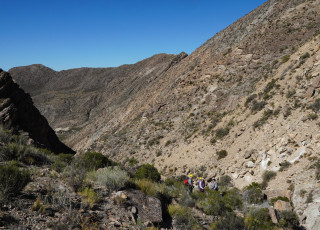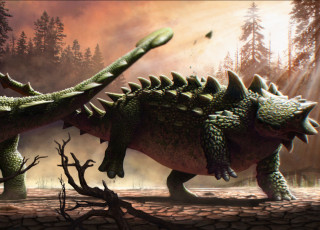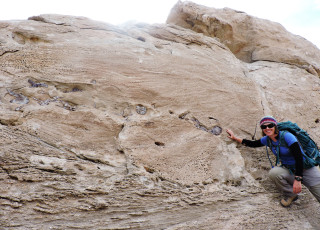Dinosaur Damage and Defense in NHMU's Collections
Just before DinoFest, we met with our paleontologists to explore the theme of dinosaur Damage & Defense. Check out the video to see some of the amazing fossils they surfaced from the collections, or read the full transcript below.
Howdy, everyone! DinoFest is back here at the Natural History Museum of Utah, and this year we're focusing on dinosaur damage. What weapons do dinosaurs have, their defenses, and the damage they inflict. We have some great examples of dino-damage here in our Museum, so let's go take a look at several of these specimens that we have here in our collections!
Tyrannosaur humerus
Today we're looking looking at this tyrannosaur humerus, so the upper arm bone. One of the cool things about this is there's a series of four gashes right here on the arm bone. These gashes are actually tooth bite impressions, so another animal was munching down on this arm bone. If we try matching the tooth marks, the two possibilities we think it could be is a tooth of this animal right here a fellow tyrannosaur, so maybe cannibalized. Or the tooth of this large alligator Deinosuchus. Which one do you think it is?
Stegosaurus plates
One of my favorite dinosaurs is Stegosaurus and as we all know Stegosaurus had tail spikes and plates along its back So, here's one of the plates that it had along its back and what's really neat is you can actually see striations, or stripes, from where the blood vessels ran the length of the plate. So, we know that it pumped blood up to the tips of the plates and maybe that helped it cool itself down. But as you can imagine, no one would want to eat something that was very crunchy with these plates and the tail spikes on it.
Allosaurus vertebrae and Stegosaurus tail spike
Another great example of dino-damage is this allosaur vertebrae right here. If you look at it, you can see this weird growth on the side. That's actually from a stegosaur spike, AKA a thagomizer, and it looks like this spike punctured right into the vertebrae and damaged the tail vertebrae of this allosaur. So, this is a possible interaction of an actual fight that happened 152 million years ago.
Ankylosaur neck armor
Another type of dinosaur that had a lot of armor were the ankylosaurs and one that we have that is just found in Utah is Akainacephalus johnsoni. This guy had armor everywhere—even its eyelids were armored! If you think about modern predator-prey relationships, let's say in the African Savannah, the big cats when they're taking down a gazelle or something they always go for the jugular, for the neck. But the ankylosaurs actually had bony armor around its neck, so I don't think T. rex could have chewed through that if it was on top, so it couldn't get it from the top. I guess if you could get close enough to roll it over, maybe it'd be easier to eat from the bottom, but this armor is just incredible.
Tyrannosaur fibula
So, growing up as a tyrannosaur is really rough here in Utah 75 million years ago. One of the cool fossils of dino-damage that we have is this tyrannosaur fibula right here. If you were to look down the length of this bone there's this weird break right here—this is where this dinosaur actually broke its leg and it re-healed offset. So, this tyrannosaur would have walked with a little bit of a limp. What made this damage in its leg, or what could have broken its leg? That would be this dinosaur, ankylosaur, with his large tail club. It's right at that height where this tail club may have smacked the tyrannosaur right in the leg, fracturing his leg. We're not for sure, but that is one of our main hypotheses, and an example of dino-damage.


